Floating row covers and plant blankets are an easy way to protect crops from chilly nights and light frosts. Row covers, floating row covers, and garden blankets are made from varying weights of synthetic materials and are used to protect plants.
Floating row covers are made of lightweight spun poly fabric and are laid loosely over plants. A floating row cover will protect plants from frost damage to 28°F.
Good Products for Season Extension at Amazon:
- Walk-In Greenhouse Tunnel 15x7x7
- Row Cover for Freeze Protection 10×30
- Garden Cloches for Plants
- Plant Cover Freeze Protection with Hoops
Row covers transmit up to 85 percent of available sunlight and are permeable to air and water. Sunlight and weather will weaken the fibers in spun poly row covers, so they should be replaced each year if they are used both at the beginning and end of the season.
Under a poly row cover the temperature will be about 10 degrees warmer than the open air at night and about 5 degrees warmer during the day.
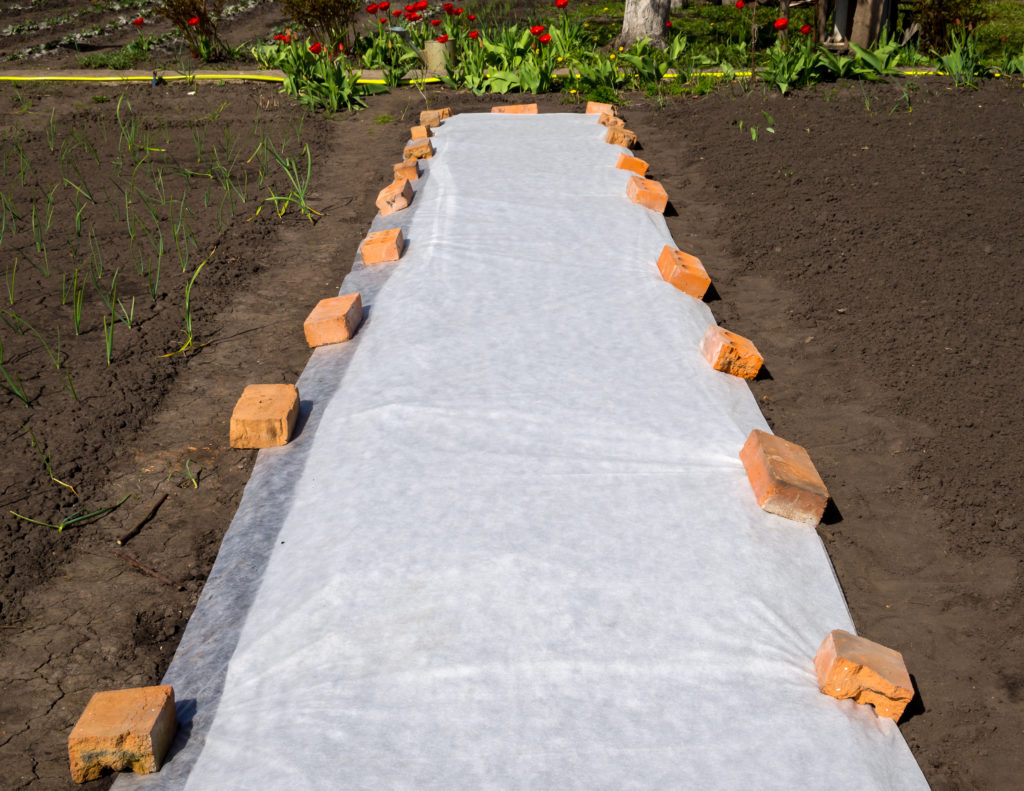
Row covers and plant blankets let water and light reach plants but keep the chill off plants and warm the soil. You can use row covers to get an early start in spring and to extend the season in fall.
Row cover material usually comes in rolls so that it can be simply rolled out over plant rows loosely and quickly. Anchor row covers to the ground on each side and the ends; use garden staples, rocks, or boards to hold row covers in place.
Light row cover material will keep plants 2 to 5°F warmer than the air outside temperature—enough to protect plants from an overnight frost—and protect plants from drying winds and insects. Row covers lift as plants grow and do not require support.
For tall plants, spun-fabric or poly cloth can be wrapped around plants to create a warming plant blanket. Hold plant blankets in place with garden or clothes pins.
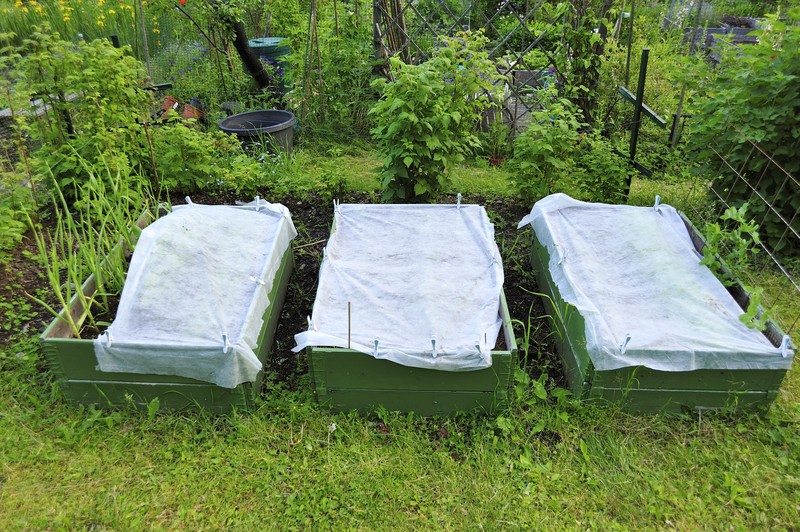
There are several product names for row cover material including Reemay, which is spun-bonded polyester; Agryl, which is spun-bonded polypropylene; and Argonet, which is a mesh of polypropylene and nylon.
Row covers and floating row covers are commonly made from spun bonded polyester or polypropylene fabric–often called horticultural cloth. Heavyweight covers are used to extend the growing season by keeping plants up to 10°F warmer during the day and 2° to 3°F warmer at night. Lightweight covers are used to exclude insects but are thin enough to allow light, water, and air to reach plants.
Row covers can be draped over hoops or frames set above rows of plants (to form protective tunnels) or they can be laid loosely or floated over plants. Medium to heavyweight row covers weighing from 1¼ to 2 ounces per square yard should be partially lifted on hot days and removed as the season advances to prevent plants from overheating.
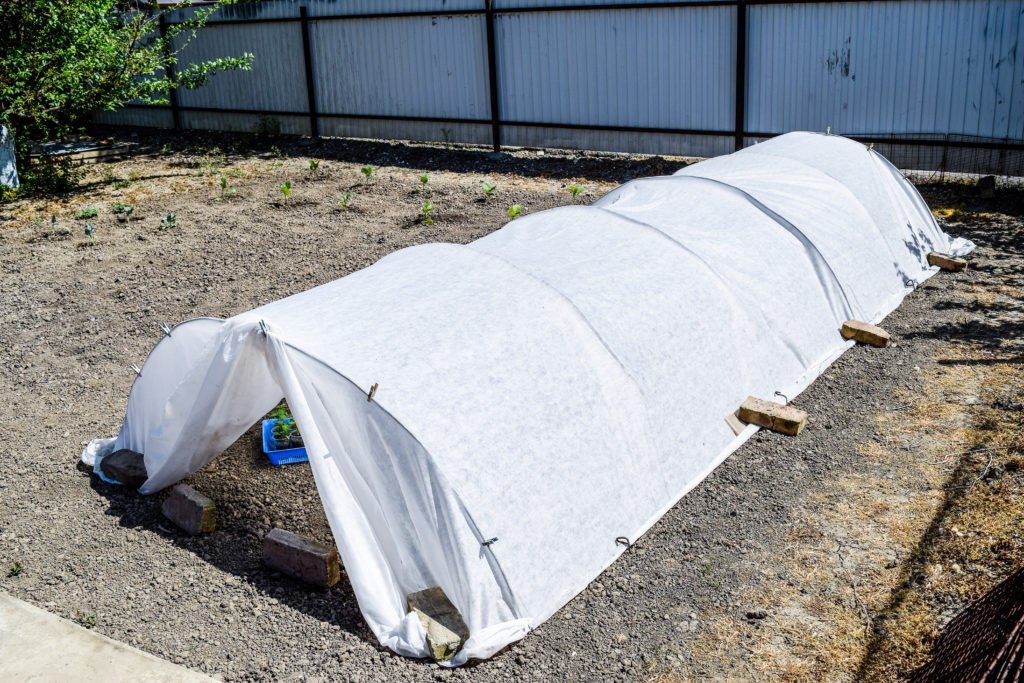
Row cover benefits
- Row covers can extend the growing season in cold-winter regions by 3 to 4 weeks in both spring and fall giving seeds and seedlings a faster start and protecting maturing crops until harvest. In warm-winter regions, row covers can protect plants all through the winter and greatly prolong the growing season and harvest.
- Row covers warm and speeds the growth of seeds, seedlings, and young plants from frost and chill early in the season. They do not warm the soil but enhance the growing environment for seedlings. Your harvest should come 1 to 2 weeks earlier.
- Slow evaporation of moisture from the soil. Protect plants from harsh sunlight.
- Protect plants from strong wind and heavy rain.
- Keep pests off plants (and stop the spread of disease by insects); be careful not to trap pests under row covers. (Covers will not protect plants from insects that emerge from the soil such as flea beetles, root maggots, tomato hornworms, Japanese beetles, and Colorado potato beetles.)
- Protect late-season crops from frost, extending the season. (Row covers can touch plant leaves with no damage, but row covers should not lie directly on fruit such as tomatoes or peppers—the fabric will transmit the outside cold to the fruit tissue causing damage.)
- Protect crops from hot temperatures and burning sun rays.
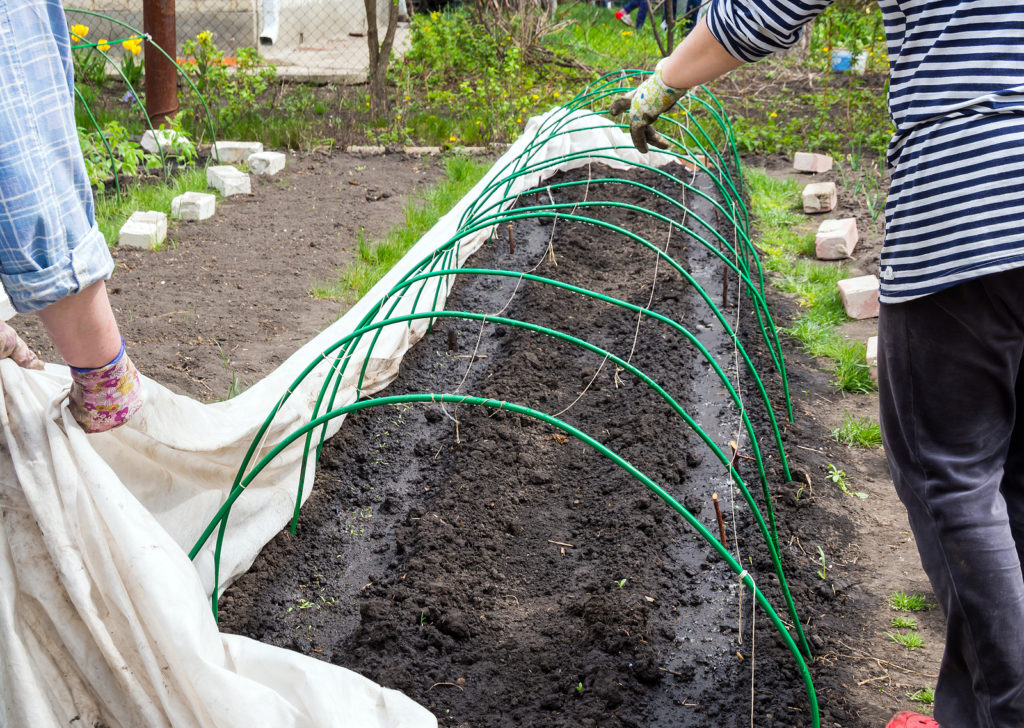
Installing row covers
- Cut the fabric to the length and width of the area you want to protect. The fabric is easily cut with garden scissors.
- Drape the fabric loosely over the plants or rows of plants; early in the season, the fabric will float up as plants grow. Late in the season, you can drape fabric over wooden or PVC frames to keep the fabric from touching fruits.
- Keep the fabric in place by holding down edges with U-shaped garden staples or by weighing down the fabric with stones, bricks, boards, or soil.
- Row covers that protect plants from frost or freezing weather should be lifted up or supported by a frame so that the fabric does not touch plant leaves. Fabric touching plants can wick killing cold temperatures to plant tissue.
- Horticultural fabric for covering plants is commonly sold in squares or rolls and is easily cut to size to cover one plant or an entire row. Covers can be held in place by garden staples, soil, boards, or bricks. A floating row cover set in place when seeds are sown or seedlings set out should have enough material for 4 to 6 weeks of plant growth, allowing the cover to float up with plant growth.
Row cover weights
Row covers are measured or graded by the weight in ounces per square yard of fabric. Heavyweight covers weigh 2 ounces per square yard; medium weight covers weigh 1¼ ounce per square yard; lightweight covers weigh a half ounce per square yard.
Heavyweight row covers
Heavyweight rows covers and garden blankets or quilts are used to protect plants from cold temperatures, chilling winds, and frosts–most often in late autumn, winter, and early spring.
Heavyweight covers (2 ounces per square yard), also called garden blankets or quilts, are commonly made of thick, close-knit polypropylene fibers. These covers are best supported above plants by plastic or fiberglass hoops or wooden frames.
Heavyweight covers can protect plants to 24°F and are commonly used in late winter or early spring to protect plants from frost or short freezes allowing the growing season to begin as much as 3 to 4 weeks earlier than average.
In cold-winter regions, heavyweight covers also can be used in late autumn and early winter to keep freezing weather from harming crops until harvest and delay soil freezing (protecting root crops). In the mild-winter regions, heavyweight covers can be used to protect root and leaf crops for harvest all winter or wintering over crops for early spring harvest.
Heavyweight row covers will block from 40 to 50 percent of sunlight and is best not used once temperatures have settled above freezing and plants begin active growth. The temperature under a heavyweight cover in warm weather can rise to as much as 20 degrees warmer than the outside temperature
Medium-weight row covers
Medium-weight or all-purpose row covers (1¼ ounces per square yard) are commonly made from spun-bonded polyester or polypropylene knitted fabric and are placed on supports over young crops or floated over the tops of stronger, mature plants.
Medium-weight row covers will protect plants from frost damage down to 28°F (2 to 6 degrees of protection). These covers will protect plants from strong winds, heavy rain, and even hail but allow light, air, and water to reach plants.
Medium-weight row covers allow from 70 to 85 percent of sunlight to reach plants and can be used for light shading in summer. Medium-weight covers also can be used to exclude insects and other pests early in the growing season.
Light-weight row covers
Lightweight floating row covers are used to shield plants from insects and diseases in spring and summer. Shade cloth is used to shade soil and plants in hot summer weather.
Lightweight row covers that are permeable to air and water and weigh about a half ounce per square yard usually do not require venting but they should be lifted when pollinating insects visit crops. Lightweight row covers can transmit up to 85 percent of the available sunlight.
Light-weight or summer-weight row covers (one-half ounce per square yard) are used to protect plants from insects, birds, and insect-borne diseases. Light-weight row covers transmit up to 95 percent of sunlight to plants. These covers are not used for frost protection, will not overheat plants in hot weather, and readily allow rain and irrigation to reach plants.

Seasonal use of row covers
Spring row covers
Prepare the soil and sow seed or set out transplants. Place or float garden fabric on the ground directly over sown seeds or seedlings or drape the fabric over hoops or a support structure. Do not stretch the fabric tight over seedbeds; allow the cover to float upwards with plant growth. Fabric over hoops can be stretched tight. Anchor the edges of covers in place with garden staples or soil.
Be sure to lift or vent the fabric during the day once daytime temperatures warm to greater than 70°F (remember temperatures underneath the cover can be 10°F or more warmer). Do not allow plants to overheat which will result in wilting and leaf or blossom drop.
Allow pollinating insects such as bees to reach crops that require insect assistance for pollination. (Insect-pollinated crops include beans, peas, pumpkins, squash, and strawberries.) Lift or remove fabric covers during the day when plants begin to flower. For self-pollinating plants such as tomatoes and peppers, covers can remain in place as long as temperatures do not rise to greater than 85°F; when temperatures rise too warm tomato pollen will become sterile and peppers will not set fruit.
Horticultural cloth will block insects from reaching plants (including aphids, potato beetles, Japanese beetles, grasshoppers, leaf miners, cabbage worms, root maggots, and some vine borers) as long as the edges of the cloth are secured. (But garden fabric will not exclude insects that emerge from the soil from insect eggs in the soil before the soil is covered.)
Summer row covers
Use lightweight garden fabric or shade cloth to protect plants from hot temperatures and intense summer sunlight. Garden fabric and shade cloth will keep soil and plants’ temperatures cooler. The horticultural cloth will slow soil moisture evaporation.
Choose shade cloth according to the intensity of the sun in your region. Shade cloth is available in weaves that will provide 30, 40, 50, 60, 70, 80, or 90 percent shade. A weave density of 60 percent or less can be used for heat-sensitive crops such as salad greens.
Set shade cloth at least 24 inches off the ground to minimize the buildup of heat and allow for the circulation of air. Support shade cloth with wire or plastic hoops or on wooden stakes or frames set up over crops.
Fall row covers
Use medium-weight garden fabric in autumn to protect cold-sensitive crops such as tomatoes and peppers from early frosts or chilling winds. Row covers put in place in the fall slow the dissipation of soil heat built up over the summer and reserve daytime solar heat into cooling autumn nights. As daytime autumn temperatures continue to drop, the medium-weight fabric can be replaced with heavyweight fabric; these fabrics should be supported by hoops or structures.
Row covers used in autumn can extend the harvest of warm-weather crops by two to three weeks in almost all regions, longer in mild-winter regions. Row covers can extend the growing season for fall cool-weather crops by a month or more.
Winter row covers
Medium- and heavyweight row covers in mild-winter regions can be used to extend the growing through the winter. Leaf and root cool-weather crops can be protected by row covers for harvest or storage through the winter. In cold-winter regions replace row covers with plastic in winter to create a cold frame or cold-weather plastic tunnel.
Common commercial brands of horticultural cloth: Horticultural cloth for row covers is sometimes sold under brand names including Remay, Agribon, Harvest Guard, Typar, and Agryl.
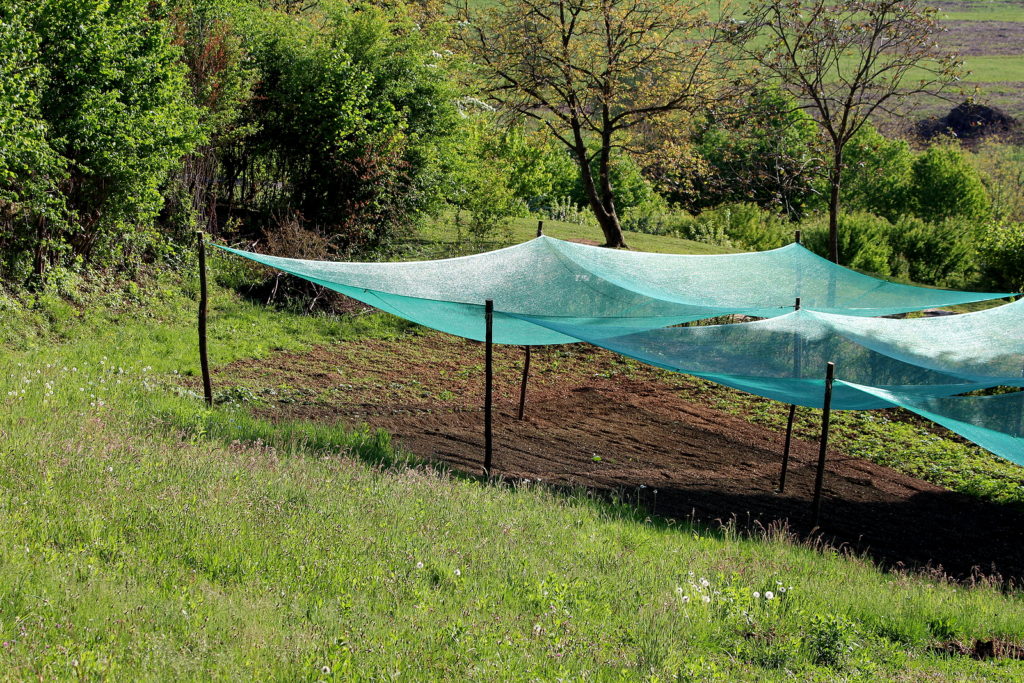
Shade cloth
Akin to row covers is shade cloth. Shade cloth is a knitted fabric often made from polyethylene or polypropylene. Shade cloth is commonly attached to a frame and set above heat-sensitive crops in summer. It can extend the growing season of crops such as lettuce and spinach which bolt or flower and go to seed if allowed to sit in the hot sun.
Shade cloth is available in a range of densities to provide 30, 40, 50, 60, 70, 80, or 90 percent shade. A density of 60 percent or less can be used for heat-sensitive crops such as salad greens.
Shade cloth should sit at least 24 inches off the ground to minimize the buildup of heat and allow for the circulation of air. Support shade cloth with wire or plastic hoops or on wooden stakes or frames set up over crops.
Also of interest:
Plastic Tunnels for Growing Vegetables
How to Prepare a Winter Vegetable Garden
Garden Planning Books at Amazon:
- Vegetable Garden Almanac & Planner
- Kitchen Garden Grower’s Guide Vegetable Encyclopedia
- Vegetable Garden Grower’s Guide
- Tomato Grower’s Answer Book















